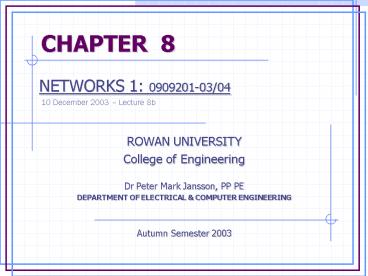NETWORKS 1: 09092010304 - PowerPoint PPT Presentation
1 / 40
Title: NETWORKS 1: 09092010304
1
CHAPTER 8
- NETWORKS 1 0909201-03/04
- 10 December 2003 Lecture 8b
- ROWAN UNIVERSITY
- College of Engineering
- Dr Peter Mark Jansson, PP PE
- DEPARTMENT OF ELECTRICAL COMPUTER ENGINEERING
- Autumn Semester 2003
2
admin
- hw 7 due today, hw 8 due at final
- test review 5.15pm thurs. at end of lab
- last lab 6 due by end of next weeks normal lab
day (no later than 5 PM) - final exam Next Mon 15 Dec 245pm
- Rowan Hall Auditorium
- take home portion
- Assignment 8 (15)
- Tool Kit (10)
3
networks I
- Todays learning objectives
- master first order circuits
- build knowledge of the complete response
- use Thevenin and Norton equivalents to simplify
analysis of first order circuits - calculate the natural (transient) response and
forced (steady-state) response
4
new concepts from ch. 8
- response of first-order circuits
- to a constant input
- the complete response
- stability of first order circuits
- response of first-order circuits
- to a nonconstant (sinusoidal) source
5
What does First Order mean?
- circuits that contain capacitors and inductors
can be defined by differential equations - circuits with ONLY ONE capacitor OR ONLY ONE
inductor can be defined by a first order
differential equation - such circuits are called First Order Circuits
6
whats the complete response (CR)?
- Complete response transient response steady
state response - OR.
- Complete response natural response forced
response
7
finding the CR of 1st Ord. Cir
- Find the forced response before the disturbance.
Evaluate at t t(0-) to determine initial
conditions v(0) or i(0) - Find forced response (steady state) after the
disturbance t t(?) Voc or Isc - Add the natural response (Ke-t/?) to the new
forced response. Use initial conditions to
calculate K
8
Figure 8.0-1 (p. 290)A plan for analyzing
first-order circuits. (a) First, separate the
energy storage element from the rest of the
circuit. (b) Next, replace the circuit connected
to a capacitor by its Thévenin equivalent
circuit, or replace the circuit connected to an
inductor by its Norton equivalent circuit.
9
RC and RL circuits
- RC circuit complete response
- RL circuit complete response
10
simplifying for analysis
- Using Thevenin and Norton Equivalent circuits
can greatly simplify the analysis of first order
circuits - We use a Thevenin with a Capacitor
- and a Norton with an Inductor
11
Thevenin Equivalent at t0
i(t)
-
12
Norton equivalent at t0
13
1st ORDER CIRCUITS WITH CONSTANT INPUT
14
Example (before switch closes)
- If vs 4V, R1 20kohms,
- R2 20 kohms
- R3 40 kohms
- What is v(0-) ?
15
as the switch closes
- THREE PERIODS emerge..
- 1. system change (switch closure)
- 2. (immediately after) capacitor or inductor in
system will store / release energy (adjust and/or
oscillate) as system moves its new level of
steady state (a.k.a. transient or natural
response) . WHY??? - 3. new steady state is then achieved (a.k.a. the
forced response)
16
Thevenin Equivalent at t0
i(t)
-
KVL
17
SOLUTION OF 1st ORDER EQUATION
18
SOLUTION CONTINUED
19
SOLUTION CONTINUED
20
so complete response is
- complete response v(t)
- forced response (steady state) Voc
- natural response (transient)
- (v(0-) Voc) e -t/RtC) NOTE ? RtC
21
Figure 8.3-4 (p. 301) (a) A first-order circuit
and (b) an equivalent circuit that is valid after
the switch opens. (c) A plot of the complete
response, v(t), given in Eq. 8.3-8.
22
WITH AN INDUCTOR
t 0
R1
R2
R3
i(t)
L
vs
Why ?
23
Norton equivalent at t0
Why ?
KCL
24
SOLUTION
25
so complete response is
- complete response i(t)
- forced response (steady state) Isc
- natural response (transient)
- (i(0-) isc) e t(Rt/L)) NOTE ? L/Rt
26
Figure 8.3-5 (p. 302) (a) A first-order circuit
and (b) an equivalent circuit that is valid after
the switch closes. (c) A plot of the complete
response, i(t), given by Eq. 8.3-9.
27
Figure E8.3-1 (p. 308)
28
Figure E8.3-2 (p. 309)
29
Figure E8.3-3 (p. 309)
30
Figure E8.3-4 (p. 309)
31
Figure E8.3-5 (p. 309)
32
Stability of 1st order circuits
- when ?0 the natural response vanishes as t ??
- THIS IS A STABLE CIRCUIT
- when ?as t??
- THIS IS AN UNSTABLE CIRCUIT
33
forced response summary
34
Unit step or pulse signal
- vo(t) A Be-at
- for t 0
35
Example
- 8.6-2, p. 321-323
36
Figure 8.6-12 (p. 322) The circuit considered
in Example 8.6-2
37
Figure 8.6-13 (p. 322) Circuits used to
calculate the steady-state response (a) before t
0 and (b) after t 0.
38
HANDY CHART
ELEMENT CURRENT VOLTAGE
39
IMPORTANT CONCEPTS FROM CHAPTER 8
- determining Initial Conditions
- determining T or N equivalent to simplify
- setting up differential equations
- solving for v(t) or i(t)
40
Dont forget HW 8 (test review)
- Thursday 5.15 pm 11 Dec after lab






























